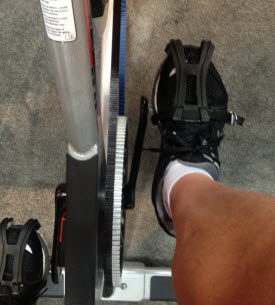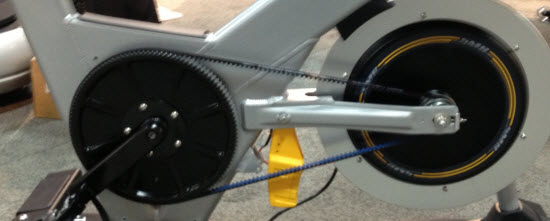
Cover removed so you can see the carbon belt and pulleys.
My Cliff's Notes review of FreeMotion's S11.9 with Carbon (belt) Drive:
Every Indoor Cycle should use this Gates Carbon Drive Belt.
It's really that good.
Strengths
- It feels very similar to a chain 🙂
- Extremely quiet
- Efficiency equal to a new chain
- Minimal required maintenance - the belt doesn't stretch and you never need to lube it.
- Should last forever
- Did I mention that it's very quiet?
Weaknesses
- More expensive than a chain drive
- It may require the pedal crankarms be spaced further apart = wider "Q-factor"
- That's all I can think of.
Disclaimer and perspective: I have taught on the FreeMotion S11.9 for the past year at two Life Time Fitness clubs. I train at home on a S11.0 (the home trainer) that was given to me for evaluation purposes.
My only real complaint with the original chain drive FreeMotion S11 series Indoor Cycles has been the amount of chain noise coming from the drive system. That noise, multiplied by 50 or more cycles in a class (or just one in a basement) can be very distracting/unsettling/frenetic and it requires much more volume of both you and your music.
If you've every experienced how calm/relaxed a class with belt driven cycles is, you'll understand exactly what I'm talking about.
Where does this additional noise comes from? It's from the chain wrapping around very small front sprocket used to rotate the flywheel at a much higher RPM than on a friction IC.

Big drive gear x small driven gear = very fast flywheel RPM
All Indoor Cycles use some form of weighted flywheel to mimic the momentum of riding a bicycle. Cycles with magnetic (Eddy Current) resistance (FreeMotion S11.x, Keiser M3 & Schwinn AC) all use an aluminum (or combination aluminum/steel) flywheel. All steel alone won't work when you're using Eddy Currents to create resistance.
Aluminum is lighter than steel = less mass = less rotating momentum. Also the design of the combination flywheels has the "steel" portion closer to the hub, resulting in less mass around the perimeter of the flywheel. The flywheel needs to rotate quite fast to create enough of these "Eddy Current's" to make the requested resistance, which is good because this additional speed makes up for the aluminum's lack of mass. The gear ratio (big crankshaft gear x small flywheel gear) needed to achieve this flywheel speed = additional chain noise.
By using a belt, instead of a chain, FreeMotion has eliminated the noise problem... but all belts are not the same...
There are a number of popular Indoor Cycles using a belt drive system; Keiser M3, Livestrong/Tomahawk and the LeMond RevMaster. All of these cycles all use a Kevlar belt - perfect for most people, except for the cyclists in your class. For them, these Kevlar belts feel very foreign. They don't "feel" like a bicycle because chains create a vibration as it rolls across the sprockets and that vibration is missing from a super smooth Kevlar belt.
I'm sure that Gates did a bunch of research and testing when they developed the Carbon Drive system as a replacement for bicycle chains. Their success (I'm presuming here) would be dependent on creating a replacement for a chain that eliminated all the negatives; maintenance, wear, weight, grease and noise - while retaining the familiar feel of riding a bicycle. The "teeth" of the carbon belt, as it rolls across the pulleys, create a similar vibration to a chain = the "feel" of a bicycle, W/O any of the negatives of a chain.
The end result - it's awesome on an Indoor Cycle.
Originally posted 2013-03-30 11:06:49.
- ICI Podcast 196 Go Cycle Studio is using the Top Power Display from Performance IQ - December 26, 2025
- You're a Celebrity… act like it! - September 24, 2025
- Lessening the pain of HIIT or Tabata® cycle training - September 18, 2025

I officially open my new studio this week – with FreeMotion S11 carbon chain drive bikes! Did a test ride today with some friends to try everything else, and everyone LOVES these bikes. I agree with everything you said… nice quiet ride, while maintaining much of the feel of a chain driven bike (to me it doesn’t feel EXACTLY the same – but it’s much closer than on a belt-drive bike).
So far very pleased!!
How exciting Jennifer – you need to send us pictures or a video of your new studio! Agreed, nothing is exactly like a chain, but these are pert-near the same feel as a bicycle.